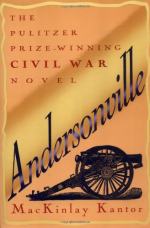Early in October they had been sent away from the City to their present location, which was then a piece of forest land. There was no stockade or other enclosure about them, and one night they forced the guard-line, about fifteen hundred escaping, under a pretty sharp fire from the guards. After getting out they scattered, each group taking a different route, some seeking Beaufort, and other places along the seaboard, and the rest trying to gain the mountains. The whole State was thrown into the greatest perturbation by the occurrence. The papers magnified the proportion of the outbreak, and lauded fulsomely the gallantry of the guards in endeavoring to withstand the desperate assaults of the frenzied Yankees. The people were wrought up into the highest alarm as to outrages and excesses that these flying desperados might be expected to commit. One would think that another Grecian horse, introduced into the heart of the Confederate Troy, had let out its fatal band of armed men. All good citizens were enjoined to turn out and assist in arresting the runaways. The vigilance of all patrolling was redoubled, and such was the effectiveness of the measures taken that before a month nearly every one of the fugitives had been retaken and sent back to Florence. Few of these complained of any special ill-treatment by their captors, while many reported frequent acts of kindness, especially when their captors belonged to the middle and upper classes. The low-down class—the clay-eaters—on the other hand, almost always abused their prisoners, and sometimes, it is pretty certain, murdered them in cold blood.
About this time Winder came on from Andersonville, and then everything changed immediately to the complexion of that place. He began the erection of the Stockade, and made it very strong. The Dead Line was established, but instead of being a strip of plank upon the top of low posts, as at Andersonville, it was simply a shallow trench, which was sometimes plainly visible, and sometimes not. The guards always resolved matters of doubt against the prisoners, and fired on them when they supposed them too near where the Dead Line ought to be. Fifteen acres of ground were enclosed by the palisades, of which five were taken up by the creek and swamp, and three or four more by the Dead Line; main streets, etc., leaving about seven or eight for the actual use of the prisoners, whose number swelled to fifteen thousand by the arrivals from Andersonville. This made the crowding together nearly as bad as at the latter place, and for awhile the same fatal results followed. The mortality, and the sending away of several thousand on the sick exchange, reduced the aggregate number at the time of our arrival to about eleven thousand, which gave more room to all, but was still not one-twentieth of the space which that number of men should have had.
No shelter, nor material for constructing any, was furnished. The ground was rather thickly wooded, and covered with undergrowth, when the Stockade was built, and certainly no bit of soil was ever so thoroughly cleared as this was. The trees and brush were cut down and worked up into hut building materials by the same slow and laborious process that I have described as employed in building our huts at Millen.




